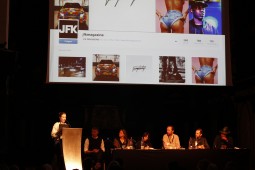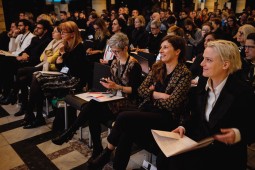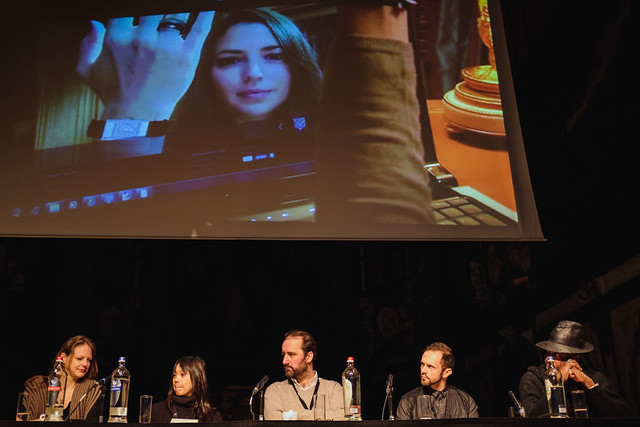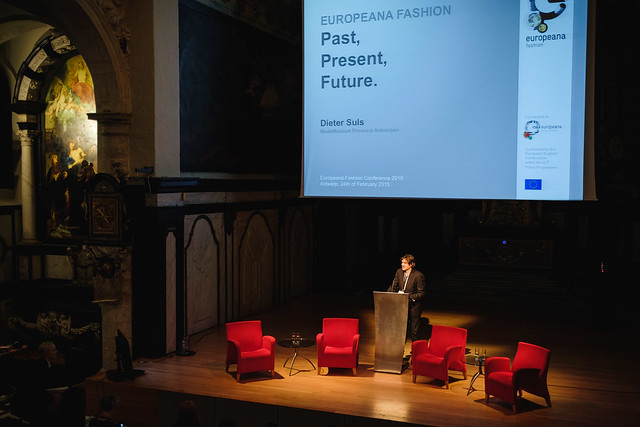Archive for March, 2015
Europeana Fashion International Conference 2015 Antwerp: Digital Fashion Futures (Day 2)

After a first day of speeches and lectures it was time to put all information of day 1 into practice on the second day of the Europeana Fashion Conference ‘Digital Fashion Futures’.
Through workshops and panel discussions about intellectual property, usage of the Europeana Fashion platform, prosumers and fashion online and what skills and competences are needed in a digital fashion era, the audience became an active participant during these sessions. The aim was to motivate, inspire and hand out tools to everyone for their journey of sharing historical costumes and collections in an online database.
New chances for the future
In her opening lecture Mila Ernst, project leader of Modemuze connects the themes of the day to the development of the project. Modemuze is an online platform initiated by seven Dutch museums and aims to connect their fashion and costume collections and present them as a source of inspiration to a broad audience of fashion lovers and professionals.
“Years of knowledge can be shared with the general public!”, says Mila Ernst. “It is an age where consumers become prosumers. There is so much knowledge amongst us.” Ernst described a subculture of people who have a fascination for historical costumes and are called re-enactors. They design their own dresses and wear them for historical dancing and accompanying soirees. There is a lot of knowledge hidden there.
And what about the costume pinners on Pinterest who yearn for more historical clothing online? Through Modemuze and Europeana Fashion, they will be able to access databases filled with items from their favorite times.
In order to achieve this, it is clear that collaboration with other parties is the key. As such, Modemuze works together with Europeana Fashion. The goal of Modemuze is to have more interactions with the general public.
For example, a group of fashion students got the opportunity to visit the archives of the Dutch Rijksmuseum to see the amount of treasures that are stored there. ”Online presence is a must. Interests are merging. The digital world opens up new chances for the future!”, says Mila Ernst.
Interacting with your audience
In her lecture, Kaat Debo Director of MoMu (Fashion Museum Province of Antwerp) couldn’t agree more. But she expresses that analog and digital can coincide and complement each other. Kaat Debo explains that awareness and a digital strategy were needed in every department of the museum in order to become interactive with their public and digitalize their collections.
Together with the Artesis University College Antwerp they started the project ‘Open Fashion’. This is a database of the collections and library of MoMu, student portfolios from the Royal Academy of Arts and the Contemporary Fashion archive – an information network on the fashion industry set up through a cooperation between five European institutions.
Archiving and structuring their database seems to be a tough task for MoMu. “Not all the images can be uploaded due to intellectual property”, explains Debo. They try to solve this by making as much agreements with designers as possible. Another issue that occurs, is having an easy access digital management system comes with a price. Funding is needed.
On a positive note, however, MoMu receives many compliments on the way they interact and communicate with their audience through Facebook and Instagram. They notice that these mediums have a higher speed and reach a larger audience.
But it does not stop there. Building a 10 square meter interactive wall at the entrance of the museum was another stepping stone in their digital adventure. Visitors and people who walk by can swipe and press on fashion images related to the museum and get information about them.
What is next for this museum? For the future Kaat Debo sees an opportunity of uploading images from the archives on your smartphone. She also feels that having a shared donations tool gives the future an interesting perspective. Maybe it is even possible to donate an euro by using your fingerprint in an app? Who knows.
Influence of online developments, a workshop hosted by Modemuze
Clearly, online developments influence the professional attitude of everyone working in the fashion sector. In the workshop ‘Virtually Everyone’ – headed by Rachid Naas – a wide variety of the sector’s opinions were represented and dicussed.
Panel member Branko Popovich for instance, who is co-director of FASHIONCLASH and a freelance reporter, feels that online developments in terms of social media give him more creative freedom. “In the past we only had social networking sites such as Hyves and Myspace. There are so many new websites now. Borders disappear. Designers out of different countries come and join FASHIONCLASH. It gives more creativity.” FASHIONCLASH connects talent, various disciplines, cultures and a broad audience through fashion events and projects such as the annual FASHIONCLASH festival.
Jonathan Chippindale of Holition hopes that this discussion about digitalisation does not occur in the future anymore. ‘Your digital and business strategy should be the same. There are new challenges. We are experimenting, fear, risk but also huge opportunities. Which are difficult but exciting!’, he says enthusiastically. His company Holition, based in the UK, uses emerging technology to create digital experiences that bridge the gap between technology and retail.
Steven Dahlberg, who is the Fashion Director of men’s magazine JFK, feels that their magazine cannot be replaced by a digital version. ‘We make a magazine to be something people want to keep and save. Internet cannot replace the feel and smell of paper.’
Intellectual property and using the Europeana Fashion platform
Sharing collections from archives of museums online is a great and innovative idea, but some of the images are copyrighted as Kaat Debo mentioned in her lecture. The panel discussion “handling intellectual property in fashion images”, chaired by V&A’s Roxanne Peters, gives some directions for where to look for answers. Know the rules of intellectual property of the country you are in! Right management of intellectual property is everything. Be practical, protect yourself and manage your risks.
Luckily there is always an opportunity to use the Europeana Fashion platform to your advantage. In the workshop “Using the Europeana Fashion platform. Tools, best practices and user cases”, panelists described their experiences in using the platform by providing their digital content to it. Even if abbreviations such as ‘API’ or ‘HTML’ scare you, you will be able to join the Europeana Fashion content pool and learn all about how to do this, explains Ykje Wildenborg from Centraal Museum Utrecht.
And it is true, with so much information on new trends and developments one can feel lost and uneducated on these topics. Although it did not become quite clear how to overcome the challenges of the internet from the workshop ‘Skills and competences for the Digital Fashion Era’, there was a lot of space for experiences and information from some of the panelists.
Virtual Fashion Designer Jacob Kok for instance gave the audience the opportunity to experience virtual reality in a fashion environment by placing a virtual reality 3D device on their heads.
The End
In the closing session ’Europeana Fashion: Communicating Fashion Heritage Online’ communication director at Europeana Fashion Allessandra Arezzi Boza focused on the project’s Tumblr. They share never seen before collections for users to get inspired and share online. On their Tumblr they came up with a curation idea called: ‘SHOWCASE’, where participants have been asked to select some images from the Europeana Fashion database to illustrate what fashion heritage means to them.
This Europeana Fashion conference marks the end of three year collaboration between the initiating partners of the project and partners that have joined the project along the way. The road towards the online fashion database has been paved and many challenges overcome, but as the conference experiences indicate: there is still a lot to be achieved also. Both Europeana Fashion and Modemuze will continue to research and adapt their presence on the web and the way they connect to the larger fashion and costume domain.
It’s especially https://order-essay-online.net important to address privacy in school settings where we’re seeing an increase in bullying
Europeana Fashion International Conference 2015 Antwerp: Digital Fashion Futures (Day 1)

Tuesday 24 February simultaneously marked the start of the Digital Fashion Futures conference and the end of the three year run of the Europeana Fashion project.
The first conference day started off with some reflections by Europeana Fashion’s team leader, Dieter Suls. Suls explained the technical aspects of the fashion heritage portal, but also talked about the development of the collaboration between all the different European partners. In the course of the day many subjects were touched upon, and many questions were raised. Below, a summary is given of all keynote lectures, panel discussions and relevant questions that were raised by the audience.
Development of the Europeana Fashion Project
Over the last three years, the Europeana Fashion project has become more than an aggregator of the digitized content and metadata of the existing fashion collections of its partners. Today the project not only encourages and supports collaborations between institutions, it also promotes user participation and contribution to the expanding content of Europeana Fashion. Although the collaborating institutions had to review their performance in an increasingly digitized world due to the targets of this project, all participating partners have decided to open up their archives to Europeana Fashion, and, in doing so, to the rest of their international network.
Digital Fashion and Academia
In the panel discussion ‘Digital Fashion and Academia’, chairman Caroline Evans focused on the influences the digital world has had, and will have, upon the different educational practices relating to the field of fashion, and the different ways in which scientific research has changed due to the expansion of this digital world. The panel concluded that due to the quality of the digital to enable the image of fashion to be distributed internationally at enormous speeds and in a wide variety of formats, it has impacted all aspects of fashion and its related academic practises. For example, fashion websites have not only changed fashion journalism, but the rest of fashion academia as well. For the first time in history fashion brands publish photographs of their whole collection online. Although fashion journalism and photography in itself is nothing new, the status of the image has changed as a result. One of the remarks made during the panel discussion is that the digital image nowadays should be considered as more than just a representation of the tangible.
Another conclusion was that since it is possible to deposit all recorded files online, there is a need for a certain focus; currently an overload of information is found on the internet. Therefore, decisions have to be made concerning what to collect and how to represent these collections in a clear manner. One overall observation by the panel was that the web has had an enormous impact on our media, on the academia and on the way we perceive fashion. Although in the past some have worried about the disruption the digital media would create with respect to print, it has become clear that it is an evolution rather than a revolution.
Engaging Communities
In the following lecture, keynote speaker Tamsen Young from the Museum at FIT in New York spoke about how the FIT is changing the way it represents its exhibitions online. In the past, all exhibitions at the museum had a personalised website. However, one of the technological difficulties the FIT faced were the many different kinds of screens their website had to adapt to. Therefore, it was necessary for Young to develop a standardized format for the websites so they could be displayed on all digital devices. Young also mentioned in her lecture that the museum is aiming at an interactive communication with its visitors through the use of digital media: ‘In the age of digital reproduction everyone is a potential broadcaster; and these days museums are opening their doors to these different voices.’
The Digital Future of Academic Fashion Publishing
Anna Wright, senior commission editor of Bloomsbury Publishing, spoke about the changing role of publishers in the age of the web. Fashion research can thrive online. Bloomsbury is aiming to serve researchers by providing everything they need on just one platform. Although the prospect of resources becoming fairly easy to find, the discussion afterwards posited some concerns among researchers. Wouldn’t the resources be tainted by the ones who provide them, because of too little critical evaluation on the website itself?
Anna Wright, senior commission editor of Bloomsbury Publishing, spoke about the changing role of publishers in the age of the web. Due to the abundance of images and information online fashion research is able to thrive. While Bloomsbury aims at providing a platform (Bloomsbury Fashion Central) containing a large amount of information concerning fashion, the audience raised the question whether or not this is a favourable option. In order to do a critical scientific research, students and academics are accustomed to consulting a variety of different sources. If the information is provided by one organisation, how could one be certain the information on this platform is critically evaluated, and therefore, useful for scholars?
The Future of Fashion Journalism in the Digital Age
Representatives of various fashion magazines, that publish in print, online or both, elaborate on the goals and perspectives of their magazines. The main focus lay on the perceived dichotomy between the romanticism of print media and the commercial necessity of digital. Questions were raised concerning the gains and the losses in printed versus digital media. One of the advantages of publishing online is that the financial cost is considerably lower compared to publishing in print, since printed magazines are in need of certain amounts of sponsoring. A concern raised by Karen Van Godtsenhoven is that there seems to be a need for speed in the publishing of information: ‘There seems to be a pressure in fashion journalism causing the need for everybody to cover the newest of the newest. For instance, publishing about previews of exhibitions. Then who covers the real exhibition?’ It was decided that online media is able to cover this speed, although the panel signalled that this speed could become problematic. It was questioned whether or not there is any room left for the in depth coverage of fashion.
Walking Dinner at MoMu
A fruitful day filled with discussion and relevant questions was brought to an ended with a wonderful walking dinner in the MoMu. During a stroll down the beautiful exhibition Dries van Noten: Inspirations we were able to discuss our findings and the sentiments expressed and explored during the day. The conclusion of the day would be: Just experiment, develop by doing.
On behalf of Europeana Fashion, thank you all for such an inspiring day!
Text contributed by ModemuzeImagine the harm that could be done to a student if professional profile writers poor performance were leaked to another student




